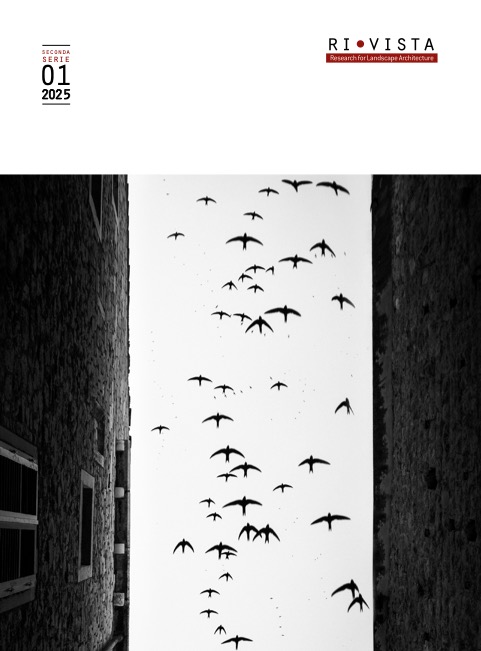Published 2025-10-28
Keywords
- Urban gardening,
- Transcultural integration,
- Civic engagement,
- Ecosocial practices,
- Uncertain spaces
How to Cite
Copyright (c) 2025 Eliana Saracino

This work is licensed under a Creative Commons Attribution 4.0 International License.
Abstract
This paper explores how urban gardening practices can serve as a tool to foster transcultural integration and support migrants in the process of redefining their identity in a new context. Through the shared care of a cultivated space, it is possible to overcome cultural barriers, fostering respect for differences while simultaneously creating a common ground for interaction, where newcomers and local communities develop a shared vision that can be extended to everyday life and public spaces. The transcultural gardens often develop in uncertain open spaces, which are therefore able to accommodate otherness and allow the emergence of alternative models of collective space. Through the analysis of established case studies, this paper highlights the different possibilities offered by these practices and demonstrates how these experimental spaces address the social and cultural needs of a global society, proposing a model of authentic integration based on dialogue and mutual respect.
References
- Amendola G. 2005, La città postmoderna. Magie e paure della metropoli contemporanea, Laterza, Roma.
- Baier A., Müller C., Werner K. 2024, Unterwegs in die stadt der zukunft. Urbane gärten als orte der transformation, transcript Verlag, Bielefeld. DOI: https://doi.org/10.1515/9783839471630
- Borja J., Castells M. 1997, Local and global. The management of cities in the information age, Taylor & Francis, Abingdon.
- Caggiano M. 2015, Les jardins partagés in Paris. Cultivating space, community and sustainable way of life, in Dessein J., Battaglini E., Horlings L. (a cura di), Cultural sustainability and regional development. Theories and practices of territorialisation, Routledge, pp. 219-234.
- Certomà C., Noori S., Sondermann M. 2019, Urban gardening and the struggle for social and spatial justice, Manchester University Press. DOI: https://doi.org/10.7765/9781526126108
- Clément G. 2005, Manifesto del terzo paesaggio, Quodlibet, Macerata.
- de Certeau M. 1984, The practice of everyday life, University of California Press, Berkeley.
- Donadieu P. 2006, Campagne urbane. Una nuova proposta di paesaggio della città, Donzelli, Roma.
- Eizenberg E. 2013, From the ground up. Community gardens in New York City and the politics of spatial transformation, Ashgate Pub., Farnham.
- Giddens A. 1999, The third way. The renewal of social democracy, Polity Press, Cambridge.
- Holston J. 1998, Spaces of insurgent citizenship, in Sandercock L. (a cura di), Making the invisible visible. A multicultural planning history, University of California Press, Berkeley, pp. 37-56. DOI: https://doi.org/10.1525/9780520918573-004
- Migliorini L., Venini L. 2001, Città e legami sociali. Introduzione alla psicologia degli ambienti urbani, Carocci, Roma.
- Moulin-Doos C. 2014, Intercultural gardens. The use of space by migrants and the practice of respect, «Journal of Urban Affairs», n. 36, pp. 197-206. DOI: https://doi.org/10.1111/juaf.12027
- Nettle C. 2014, Community gardening as social action, Routledge, Abingdon.
- Sendra P., Sennett R. 2022, Progettare il disordine: idee per la città del XXI secolo, Treccani, Roma.
- Soja E. W. 1996, Thirdspace. Journeys to Los Angeles and other real-and-imagined places, Blackwell, Cambridge.
- Wood P., Landry C. 2008, The intercultural city. Planning for diversity advantage, Earthscan, London.





